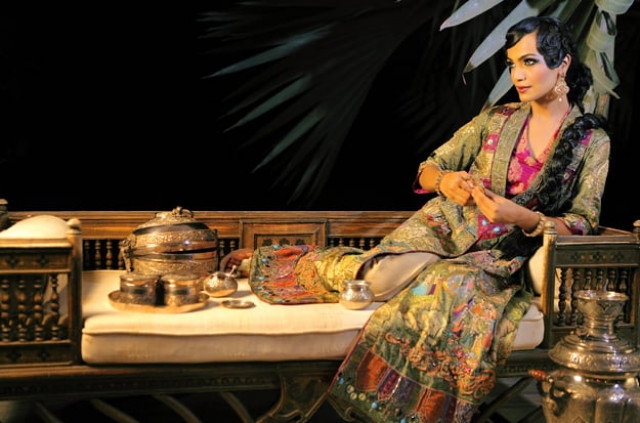Exuding regality of the Mughal era
With unique creative sensibilities, Umbereen and Sharmeen’s designs are a real work of art.

While the artistry and conceptualisation of such chadars is remarkable, some would argue that Umbereen and Sharmeen are ‘textile’ designers rather than ‘fashion’ designers.
Does fashion qualify as art? This is a question that the fashion fraternity has remained divided on. While it is arguable that a beautifully cut dress or creative ramp presentation is a form of fine art, Pakistani designers and sisters Umbereen and Sharmeen create harmony between fashion and art through their label Umbreen&Sharmeen.
When Umbereen describes herself as an artist rather than a designer, it’s tempting to consider this as an example of the pretentiousness of the fashion world. But when she brings out her designs, it becomes clear that their work is not fashion as we know it. For Umbereen and Sharmeen, their works are expressions of the message they want to convey and a way of depicting strong emotions and opinions.
One of the exceptional pieces that Umbereen displays is a Mughal-themed chadar (large, heavily-worked dupatta) that depicts the dichotomy between male and female worlds of the time. One end of the chadar shows the men hunting, at war, in consultation with each other and generally being active. The women’s end is more passive, depicting flowers, dances and ladies-in-waiting. Surrounded by a beautiful garden, a man and a woman meet in the centre of the piece. The chadar is simply exquisite – hand-worked in tiny stitches of single resham and comprising rich colours, which exude the romanticism of the era.
Another outstanding chadar depicts seven different types of birds in an intricate garden. From songbirds to vultures, various species are showcased amid elaborate flowers and leaves. The concept behind this piece is to portray how people of different backgrounds, cultures and sects can coexist in harmony. The delicacy and beauty of the work is laudable and the chadar seems to be destined to become an heirloom.

While the artistry and conceptualisation of such chadars is remarkable, some would argue that Umbereen and Sharmeen are ‘textile’ designers rather than ‘fashion’ designers. Umbereen and Sharmeen focused on textile design when they first launched their eponymous label in 1997, gradually moving into prêt, formals and bridals. Now, however, as any of Karachi’s fashion cognoscenti will tell you, the label is a full-fledged design house.
Umbereen and Sharmeen’s fashion-forward cuts and silhouettes are as attractive as their embroidery and embellishments. Their collections include avant-garde outfits as well as more conventional silhouettes to cater to the conservative clientele. A recent bridal featured an asymmetric kameez with palazzos and an embroidered waistcoat. Whether a client wants to wear a jumpsuit, lehenga choli or traditional farshi, Umbereen and Sharmeen offer a wide variety. A recent visit to their showroom revealed a pair of polki-embroidered pants and a Mughal-embroidered short angarka that worked well together.
The charmingly bohemian Umbereen explains that their current collection features a lot of Mughal-inspired elements – from figures to paisleys and other motifs. Mughal figures are trendy, but Umbereen and Sharmeen’s driving point is their hope for political harmony as well as disaffection with the current atmosphere of violent intolerance. Through their work, they want to depict a time when people of the subcontinent lived together more harmoniously.
Umbereen concedes that the Mughal era was far from perfect, but that they are trying to portray a message of peace and tolerance by evoking our rich cultural heritage. In doing so, Umbereen and Sharmeen have used bright flowers and rich fabrics to portray prosperity, which they feel stems from tolerance. Umbereen mentions that they are currently planning a range that reflects Turkish influence on our culture. They are also working on miniature coffee table books to accompany their signature heritage chadars to set a background behind the piece you own.
One of the most attractive features of Umbereen and Sharmeen’s designs is their versatility. Their formal and prêt wear are designed as separates, which can be dressed up or down depending on the item they are paired with. Their heritage chadars can also be worn in many ways – with a jumpsuit, sari, shalwar kameez or even a dress. Their heavier joras are essentially timeless outfits in classic styles, while you’ll find a higher proportion of trendier cuts in their prêt collection. The fact that every bridal ensemble is unique and each signature heavy piece is a limited edition is particularly appealing.

Umbereen and Sharmeen display sensitivity to their clients’ wishes, which is refreshing. They will customise everything from colours to cuts to embroidery. Many outfits from their latest collection feature figures, but they are flexible about replacing these with floral and other motifs for clients who prefer not to wear figures. Most of their embroidery is handwork, but they will even replace this with machine work to suit their clients’ budget, if necessary.
Given the time-consuming artisan nature of the handwork that they employ, their prices are relatively reasonable. Their impeccable finishing, filigree-like embroidery and sophisticated design aesthetic make Umbereen&Sharmeen one of Karachi’s most covetable labels.
Oxford-grad Salima Feerasta is a social commentator and lover of style in any form or fashion. She blogs at karachista.blogspot.com and tweets @karachista
Published in The Express Tribune, May 23rd, 2014.
Like Life & Style on Facebook, follow @ETLifeandStyle on Twitter for the latest in fashion, gossip and entertainment.



















COMMENTS
Comments are moderated and generally will be posted if they are on-topic and not abusive.
For more information, please see our Comments FAQ